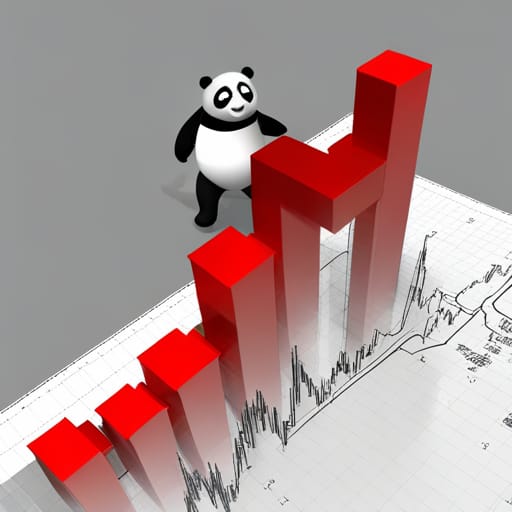
Decoding the Secrets: What Are Economic Indicators
Oct 2, 2023
Introduction:
In the intricate tapestry of economics, gaining insight into the vitality and trajectory of an economy often appears as challenging as solving a complicated puzzle. Yet, within this realm, there exists a set of tools that can serve as our guiding stars, illuminating the path to comprehension. These tools are none other than economic indicators. But what are economic indicators exactly? This article embarks on a journey to unravel the enigma enshrouding economic indicators, exploring their diverse types, their significance in the economic landscape, and the profound ways they can be harnessed to decipher the ever-shifting patterns of economic trends.
Economic indicators, in essence, are like signposts that beckon us to explore the complex terrain of an economy. They are statistical data points and metrics that encapsulate many economic activities, condensed into digestible nuggets of information. These indicators are akin to the vital signs of an economy, offering crucial insights into its overall well-being, vitality, and potential areas of concern.
You might be wondering Why I should care about economic indicators. The answer lies in their ability to act as powerful forecasting tools. Much like meteorologists use weather indicators to predict storms and sunshine, economists and policymakers utilize economic indicators to foresee economic storms, such as recessions or sunny days of economic growth. They provide an invaluable glimpse into the future, allowing individuals, businesses, and governments to make informed decisions and prepare for what lies ahead.
The world of economic indicators is a vast and multifaceted one. It encompasses an array of metrics that span from the highly publicized Gross Domestic Product (GDP) to more specialized indicators like the Consumer Price Index (CPI) and the Purchasing Managers’ Index (PMI). Each hand serves a unique purpose, collectively forming a mosaic of economic information that paints a picture of an economy’s overall health.
As we delve deeper into this exploration, we will uncover the diverse types of economic indicators and their significance on a micro and macro scale. Furthermore, we will elucidate how these indicators serve as the lifeblood of financial analysis, guiding everything from investment decisions to government policies. So, fasten your seatbelts as we embark on a captivating journey to unravel the world of economic indicators, decoding the secrets they hold and the insights they offer.
Understanding Economic Indicators:
Economic indicators play a crucial role in understanding the financial health of a country and predicting future trends. These indicators are essential tools that analysts, policymakers, and economists use to assess the current state of the economy and make informed decisions.
Leading indicators are economic factors that change before the economy starts to follow a particular pattern or trend. They provide valuable insights into future economic conditions and help anticipate potential shifts in the market. Examples of leading indicators include stock market performance, building permits, and consumer sentiment surveys. Economists can understand the economy’s direction by analysing these indicators and making predictions accordingly.
On the other hand, lagging indicators are economic factors that change after the economy has already begun to follow a trend. They confirm the economy’s direction and provide evidence of past financial performance. Examples of lagging indicators include unemployment rates, corporate profits, and labour cost per output unit. These indicators help validate the trends observed in the economy and provide a retrospective view of its health.
Coincident indicators change at the same time as the economy or stock market. They provide real-time information about the current state of the economy and offer insights into its overall health. Coincident indicators include personal income, industrial production, and retail sales. Analysts can gauge the immediate economic conditions by monitoring these indicators and making timely decisions.
Understanding the different types of economic indicators is crucial for comprehending the complexities of the economy. By analyzing leading, lagging, and coincident indicators collectively, economists can gain a more comprehensive understanding of the economic landscape and make more accurate predictions.
It’s important to note that economic indicators are not standalone measures but rather pieces of a larger puzzle. They should be interpreted with other financial data and expert analysis to form a complete picture of the economy. Additionally, economic indicators can vary in reliability and accuracy, so it’s essential to consider the source and methodology behind each indicator.
Leading Indicators: Predicting the Future
Leading indicators are indeed valuable tools for predicting changes in the economy. While they are not always 100% accurate, they provide valuable insights into potential shifts in economic trends. Let’s explore some examples of leading indicators in more detail:
1. Stock Market Performance: The performance of stock markets is often considered a leading indicator. When stock markets are performing well, it can indicate investor confidence and optimism about the future state of the economy. Conversely, a decline in stock market indices may suggest a potential economic downturn.
2. Building Permits: The number of building permits issued is another leading indicator. An increase in building permits suggests a growing demand for construction, which can be indicative of economic expansion. It reflects increased investment in infrastructure, commercial properties, and residential housing.
3. Consumer Sentiment Surveys: Consumer sentiment surveys measure the confidence and outlook of consumers regarding the economy. When consumer sentiment is positive, it often translates into increased consumer spending, which drives economic growth. Conversely, a decline in consumer sentiment may indicate a potential slowdown in economic activity.
These examples demonstrate how leading indicators can provide valuable insights into the economy’s future direction. However, it’s important to note that no single hand should be relied upon in isolation. The collective analysis of multiple indicators provides a more comprehensive understanding of economic trends.
Economists and analysts can gain a more holistic view of the economy by monitoring leading indicators alongside lagging and coincident indicators. This allows for better-informed decision-making and anticipating potential changes in economic conditions.
Leading indicators play a crucial role in predicting economic changes. They provide valuable insights into future trends and can help individuals, businesses, and policymakers make informed decisions. By understanding and analyzing leading indicators, we can navigate the complexities of the economic landscape with greater confidence.
Lagging Indicators: Confirming the Trend
Lagging indicators are critical economic factors that confirm trends that have already occurred in the economy. They help validate the economy’s direction and provide evidence of past financial performance. Let’s explore some examples of lagging indicators in more detail:
1. Unemployment Rates: Unemployment rates are a commonly used lagging indicator. When the economy is experiencing a downturn, unemployment rates tend to rise as businesses reduce their workforce. Conversely, during periods of economic growth, unemployment rates tend to decline as job opportunities increase.
2. Corporate Profits: Corporate profits are another lagging indicator that reflects the financial performance of businesses. When corporate profits are high, companies are generating revenue and experiencing growth. Conversely, a decline in corporate profits may suggest economic challenges or a slowdown in business activity.
3. Labor Cost per Unit of Output: This indicator measures the cost of labour required to produce a unit of output. It provides insights into the efficiency and productivity of the workforce. When delivery costs per unit of output increase, it may indicate rising wages or decreased productivity, which can impact business profitability.
These examples demonstrate how lagging indicators can provide valuable insights into the economy’s past performance. Economists and analysts can better understand the overall economic trends and make informed decisions by analysing these indicators.
Lagging indicators are retrospective and may not provide immediate insights into the current state of the economy. However, they are crucial in confirming the economy’s direction and delivering a historical context for economic analysis.
Coincident Indicators: Present Economic Health
Coincident indicators are valuable tools for assessing the present economic health of a country. They provide real-time information about the current state of the economy and offer insights into its overall performance. Let’s explore some examples of coincident indicators in more detail:
1. Personal Income: Personal income is a coincident indicator that measures the total income received by individuals from various sources, such as wages, salaries, and investments. An increase in personal income indicates a rise in individual purchasing power, which can stimulate economic activity.
2. Industrial Production: Industrial production measures the output of manufacturing, mining, and utilities sectors. It provides insights into the production level and the industrial sector’s health. When industrial production is high, it suggests a robust manufacturing sector and a favourable economic environment.
3. Retail Sales: Retail sales reflect retail establishments’ total sales of goods and services. They are a crucial indicator of consumer spending, a significant economic growth driver. Increased retail sales indicate higher consumer confidence and a thriving retail sector.
These examples demonstrate how coincident indicators can provide valuable insights into the current state of the economy. By monitoring these indicators, economists and analysts can gauge the immediate economic conditions and make timely decisions.
The Importance of Economic Indicators
Economic indicators are indeed crucial for understanding the state of a country’s economy and making informed decisions. They provide valuable insights into various aspects of the economy and serve multiple purposes. Let’s explore the importance of economic indicators in more detail:
Snapshot of Economic Health:
Economic indicators provide a snapshot of a country’s financial health at a specific time. They offer valuable insights into various aspects of the economy, such as GDP growth, inflation rates, employment levels, and trade balances. By analyzing these indicators, we can better understand the economy’s overall state and its potential impact on different sectors.
For businesses, economic indicators help assess market conditions and make informed decisions. They provide valuable information on consumer spending patterns, business investment trends, and overall financial stability, which can guide companies in their strategic planning and decision-making processes.
Investors also rely on economic indicators to evaluate investment opportunities and manage risks. By monitoring indicators such as interest rates, stock market performance, and currency exchange rates, investors can assess the overall investment climate and make informed decisions about asset allocation and portfolio diversification.
Furthermore, economic indicators play a crucial role in policymaking. Governments and central banks use these indicators to assess the effectiveness of current policies, identify areas of concern, and implement appropriate measures to stimulate economic growth or address potential risks.
Overall, economic indicators provide valuable insights into the current state of the economy and its potential impact on businesses, investments, and the standard of living. By monitoring and analyzing these indicators, individuals and organizations can make more informed decisions and navigate the complexities of the economic landscape with greater confidence.
Forecasting Economic Trends:
By analyzing these indicators, economists can predict future economic conditions, which can help businesses and investors make informed decisions. Economic indicators provide valuable insights into the current state of the economy and can serve as practical tools for forecasting trends.
For example, the GDP growth rate is a commonly used indicator to forecast economic trends. If the GDP growth rate is consistently high over time, it suggests a strong and expanding economy. This information can be helpful for businesses looking to expand their operations or investors seeking opportunities in growing sectors.
Another example is the unemployment rate. A declining unemployment rate indicates a healthy job market and potential economic growth. This information can be valuable for businesses planning their workforce and investors assessing the stability of the labour market.
Economic indicators, such as inflation rates, consumer spending, and business investment, can provide insights into future economic trends. Economists can predict the economy’s direction and potential impact on various sectors by analyzing these indicators in conjunction with other relevant data.
Guiding Policymakers:
Economic indicators indeed play a crucial role in guiding policymakers. They provide valuable data to help policymakers make informed decisions about economic policies, such as interest rates, tax policies, and government spending. By analyzing economic indicators, policymakers can gain insights into the current state of the economy and identify areas that require attention or intervention.
For example, let’s consider the role of economic indicators in setting interest rates. Central banks closely monitor indicators such as inflation rates, GDP growth, and employment levels to assess the economy’s overall health. If inflation rises above the target range, policymakers may consider raising interest rates to curb inflationary pressures. Conversely, if the economy is experiencing a slowdown, policymakers may lower interest rates to stimulate borrowing and spending.
Tax policies are another area where economic indicators play a significant role. By analyzing indicators such as income levels, consumer spending, and business investment, policymakers can assess the impact of tax policies on different segments of the population and the overall economy. Economic indicators help policymakers evaluate the effectiveness of existing tax policies and make informed decisions about potential adjustments or reforms.
Economic indicators also influence government spending decisions. By monitoring indicators such as GDP growth, employment levels, and fiscal deficits, policymakers can determine the appropriate level of government spending to support economic growth and stability. Economic indicators provide valuable insights into the overall fiscal health of the country and help policymakers allocate resources effectively.
Economic indicators provide policymakers with valuable data to make informed decisions about financial policies. By analyzing these indicators, policymakers can assess the current state of the economy, identify areas that require attention, and adjust interest rates, tax policies, and government spending. Economic indicators are essential in guiding policymakers towards promoting economic growth, stability, and the country’s overall well-being.
Assessing Business Opportunities
Economic indicators play a crucial role in helping businesses assess market conditions and identify potential opportunities. By monitoring indicators such as consumer spending, business investment, and housing starts, companies can make informed decisions about expanding operations, launching new products, or entering new markets.
Consumer spending is a key indicator that reflects consumers’ purchasing power and confidence. Businesses can identify trends and adjust their strategies by analysing consumer spending patterns. For example, if consumer spending is rising, it may indicate a favourable market for introducing new products or expanding existing product lines.
Business investment indicators provide insights into the level of investment activity in the economy. By monitoring indicators such as capital expenditure and business confidence, companies can gauge the overall business environment and decide to invest in new equipment technology or expand their operations.
Housing starts, which measure the number of new residential construction projects, can also be a valuable indicator for businesses. It reflects the demand for housing and can provide insights into the overall health of the construction industry. Companies related to real estate, construction materials, or home furnishings can use this information to assess market conditions and identify potential opportunities.
Evaluating Investment Risks
Investors indeed rely on economic indicators to evaluate investment risks and make informed decisions. Indicators such as interest rates, stock market performance, and currency exchange rates provide insights into the overall investment climate and potential returns. By analyzing these indicators, investors can assess the risks associated with different investment options and adjust their portfolios accordingly.
Interest rates play a crucial role in investment decisions. When interest rates are low, it can stimulate borrowing and investment, potentially leading to higher returns on investments. Conversely, borrowing costs increase when interest rates are high, which can impact investment returns. Monitoring interest rate trends can help investors decide about fixed-income investments, such as bonds or savings accounts.
Stock market performance is another important indicator for investors. By analyzing stock market indices, such as the S&P 500 or the Dow Jones Industrial Average, investors can assess the market’s overall direction and identify potential risks or opportunities. Buoyant stock market performance may indicate a favourable investment climate, while negative performance may signal potential risks.
Currency exchange rates also affect investment decisions, especially for international investors. Fluctuations in exchange rates can impact the returns on foreign investments. Monitoring currency exchange rates can help investors assess the potential risks and returns associated with investing in different countries or currencies.
It’s essential for investors to regularly monitor these economic indicators and analyze them in conjunction with other relevant factors, such as market trends, company fundamentals, and risk tolerance. This comprehensive approach allows investors to make informed decisions, manage risks, and optimize their portfolios.
Using Economic Indicators:
While economic indicators provide valuable insights, it’s essential to understand how to use them effectively. In this discussion, we will delve into crucial concepts, such as comprehending the indicator’s nuances, considering the context in which it applies, monitoring trends and patterns, utilizing multiple data points for a holistic view, staying informed about market dynamics, looking at the bigger picture, and evaluating the credibility of information sources. These strategies are crucial for making informed decisions based on economic indicators.
Understand the Indicator:
Each economic indicator measures a specific aspect of the economy and provides valuable insights into different areas of economic activity. Understanding what each indicator measures and how it is calculated is crucial for interpreting the data accurately and making informed decisions.
For example, the Gross Domestic Product (GDP) measures the total value of goods and services produced within a country’s borders over a specific period. It is calculated by summing up the value added by each economic sector. GDP is a widely used indicator to assess a country’s overall economic performance and growth.
Another example is the Consumer Price Index (CPI), which measures changes in the average prices of a basket of goods and services commonly purchased by households. It helps gauge inflationary pressures and the purchasing power of consumers.
Understanding the methodology behind each indicator is essential to interpret the data correctly. For instance, the unemployment rate is calculated by dividing the number of unemployed individuals by the total labour force and multiplying it by 100. By understanding the formula and the criteria used to define unemployment, we can better analyze the implications of changes in the unemployment rate.
In conclusion, understanding what each economic indicator measures and how it is calculated is crucial for accurate interpretation and informed decision-making. By delving into the details of each indicator, we can gain a deeper understanding of the economy and utilize the insights provided by these indicators more effectively.
Consider the Context
Analyzing economic indicators in the context of other relevant factors and trends is crucial for understanding the overall economic situation comprehensively. By considering multiple indicators and their interrelationships, we can paint a more accurate picture of the economy and make more informed decisions.
For example, when analyzing GDP growth, it’s essential to consider factors such as inflation, employment rates, and consumer spending. If GDP is proliferating but accompanied by high inflation, it may indicate an overheating economy with potential risks of inflationary pressures. Similarly, if GDP growth is strong but employment rates remain low, it may suggest a mismatch between economic growth and job creation.
Consumer spending is another important factor to consider. High GDP growth may be driven by robust consumer spending, indicating a healthy economy. On the other hand, if GDP growth is strong but consumer spending is sluggish, it may raise concerns about the sustainability of the growth and potential future economic challenges.
We can gain a more holistic view of the economy by analysing economic indicators with other relevant factors. This allows us to identify potential risks, spot emerging trends, and make more informed decisions. It’s important to remember that economic indicators are not standalone measures but pieces of a giant puzzle. Considering the context helps us connect the dots and understand the underlying dynamics of the economy.
Monitor Trends
Monitoring trends in economic indicators is a valuable practice for gaining insights into the economy’s direction and making informed predictions about future developments. By analyzing data over time, we can identify patterns and patterns that can help us understand the underlying dynamics of the economy.
For example, let’s consider the trend of GDP growth over several quarters or years. By monitoring the changes in GDP over time, we can identify whether the economy is expanding, contracting, or experiencing periods of stability. This information can be helpful for businesses and investors in planning their strategies and making informed decisions.
Similarly, tracking trends in indicators such as inflation rates, employment levels, and consumer spending can provide valuable insights into the economy’s overall health. For instance, if inflation rates have steadily increased over time, it may indicate potential risks of rising prices and impact purchasing power. On the other hand, if employment levels have been consistently rising, it suggests a positive trend in job creation and economic growth.
By monitoring trends in economic indicators, we can identify potential opportunities and risks, adjust our strategies accordingly, and make more informed predictions about future economic developments. However, it’s important to note that various factors can influence economic trends, and careful analysis is required to interpret the data accurately.
Use Multiple Indicators:
Analyzing multiple economic indicators is indeed crucial for gaining a comprehensive understanding of the economy. Relying on a single indicator may provide limited insights and may not capture the full complexity of economic conditions.
We can obtain a more holistic view by considering a range of indicators covering different aspects of the economy. For example, GDP growth provides information about the overall output and performance of the economy, while consumer confidence reflects consumers’ sentiment and spending behaviour. We can better understand the relationship between economic performance and consumer behaviour by analysing both indicators together.
Other indicators, such as inflation rates, employment levels, and business investment, can also provide valuable insights into different aspects of the economy. By examining these indicators collectively, we can identify trends, patterns, and potential interdependencies that may impact economic conditions.
Stay Informed:
Staying informed about the latest economic indicators, releases, and updates is crucial for accurate and up-to-date analysis. Government agencies, central banks, and other reputable sources regularly publish financial data. By staying updated, you can ensure that you have the most current information to inform your analysis and decision-making.
To stay informed, you can regularly check the websites of relevant government agencies, central banks, and economic research institutions. These organizations often provide timely updates on economic indicators, including release schedules and data publications. Additionally, financial news outlets and economic publications can also be valuable sources of information, providing analysis and insights on the latest economic data.
It’s important to note that economic indicators are subject to revisions and updates as new data becomes available. Therefore, it’s advisable to double-check the data and ensure that you are using the most recent figures for your analysis.
By staying informed and keeping up with the latest releases and updates, you can ensure that your analysis is based on the most accurate and current economic data.
Look at the Big Picture:
You are correct that looking at multiple economic indicators is essential for obtaining a comprehensive view of the economy. No single hand can provide a complete picture of the economic conditions. By analyzing various indicators covering different aspects of the economy, we can gain a more holistic understanding of its health and performance.
For example, while GDP growth is an essential indicator of economic activity, it does not capture other crucial factors such as inflation, employment rates, or consumer sentiment. We can paint a more accurate and nuanced picture of the overall economic conditions by considering multiple indicators, such as inflation rates, unemployment rates, consumer spending, business investment, and trade balances.
Each indicator provides insights into a specific aspect of the economy, and by examining them collectively, we can identify trends, patterns, and potential interdependencies that may impact economic conditions. This comprehensive approach allows us to understand the complexities of the economy better and make more informed decisions.
Consider the Source:
You are correct that the reliability of economic indicators can vary depending on the source. It is essential to consider the credibility and reputation of the original when analyzing economic data. Reputable sources, such as government agencies, central banks, and well-established research institutions, often provide reliable and accurate economic indicators.
When evaluating the credibility of a source, consider factors such as the expertise and track record of the organization or institution, the transparency of their data collection and analysis methods, and whether the data is subject to independent verification or peer review. It is also helpful to consult multiple sources to cross-reference the data and ensure consistency.
By considering the source and its credibility, you can have more confidence in the accuracy and reliability of the economic indicators you are analyzing. This allows for a more informed and accurate assessment of the economic conditions.
Concluding thoughts: What Are Economic Indicators
In conclusion, economic indicators are powerful tools that provide valuable insights into the health and direction of an economy. By understanding economic indicators and how to use them effectively, we can make more informed decisions in various areas such as business, investment, and policymaking.
Throughout this discussion, we have explored the different types of economic indicators, including leading, lagging, and coincident indicators. We have seen how leading indicators can help predict future trends, lagging indicators can confirm the economy’s direction, and coincident indicators provide a snapshot of the present economic health.
We have also highlighted the importance of considering the context when analyzing economic indicators. By looking at multiple hands and considering other relevant factors and trends, we can obtain a more comprehensive view of the economy and make more accurate assessments.
Furthermore, we have emphasized the need to stay informed about the latest releases and updates of economic indicators. Keeping up with the most current data ensures that our analysis is based on the most accurate and up-to-date information available.
Lastly, we have discussed the importance of considering the source and credibility of economic indicators. It is crucial to rely on reputable sources and institutions that provide reliable and transparent data.
However, it is essential to remember that economic indicators are just tools and should be used with other information and expert advice. Economic conditions are complex and influenced by various factors, and a holistic approach is necessary for making well-informed decisions.
In conclusion, economic indicators provide valuable insights into the economy but should be used as part of a broader analysis. By combining economic indicators with other data sources and expert knowledge, we can navigate the complexities of the financial landscape and make more informed decisions.










